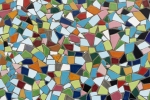September 2021
Celebrating Hispanic Heritage Month
My Spiritual Art Journey
https://www.thegatheringofleaders.org/ Art and spirituality have been a part of my life ever since early childhood. As the son of the late Bishop Leonardo Romero, from the Diocese of Northern Mexico, I have fond memories of my mother bringing a sketchpad, pencils and crayons for me to entertain myself as my father celebrated mass or facilitated church events. With my father and the church as my inspiration, my artwork depicted what I saw, heard, felt and eventually read during these happenings. Crosses, angels and Bible stories, as well as the people I congregated with, provided a rich source of inspiration for me.
This inspiration carried on in my artistic endeavors at home and beyond. I remember crafting a chalice and patent out of a Parkay margarine tub – two tub lids, a toilet paper tube and aluminum paper – so that I could play priest. (My mother has reminded me that I even passed around a “collection plate.”)
Wanting to foster my love of art, my parents eventually enrolled me in art classes. Not only did I take a drawing course by mail, but I was also enrolled in oil painting classes throughout my youth. Of course, I usually hummed or sang church hymns as I worked on my artwork.
Exploring art and spirituality
Art and spirituality have continued to be a part of my life to this day. The first degree I earned was a Bachelor of Fine Arts. It allowed me to experiment with a wide range of media, which I found spiritually exhilarating. However, I also discovered that not all forms of art are spiritual. I worked in the advertising world for a while and did well, but I learned that when I used art as a means to an end, it wasn’t always spiritually fulfilling. For that to happen, I had to use it to explore the present and claim a sense of what is authentic to me. As Dr. Betty Edwards said in her book Drawing on the Right Side of the Brain, “artwork should be an expression of who you are…a reflection of your style.”
As a Christian, I know we were created in the image of God, and as such, we have inherited the gift of creativity. This is addressed in Exodus 31:1-6, where God talks to Moses about Bezalel and the building of the Tabernacle: I have filled him with the Spirit of God, in wisdom, in understanding, in knowledge and in all manner of workmanship, to design artistic works… and I have put wisdom in the hearts of all the gifted artisans, that they may make all that I have commanded you.
Hence, I believe that spiritual art can be expressed in a variety of ways – in writing, music, woodwork, stitchery, quilting, photography and more. Styles and themes may also vary, according to each person’s likes and preferences. It’s not limited to iconography, but extends to other art forms as well, such as etegami, book illustrating, and more.
So what makes art spiritual? I believe spiritual art should reflect the principles and values of beauty, heartfulness, creativity, honesty, generosity, discernment, patience, perseverance, profound emotion and the transcendence of God. Hence, prayer, contemplative reading, meditation, Christian music and even incense may be involved. This can begin with a nature walk, a life experience, and other memorable issues. It’s about being in touch with ones personal feelings, emotions, and thoughts. This can evolve into words, images, rhythms, designs and more. It’s about letting go, so that creativity may flourish. Spirituality does not have to mean religious imagery, for “the heavens and the earth were completed in all their vast array” by our Lord and Creator (See Genesis 1-2:2).
It’s the process that matters most
The spiritual creative process can be messy. Think about Genesis 1, “In the beginning… the earth was formless and empty, darkness was over the surface of the deep.” From that chaos, God created something that “was good.” In my opinion, that’s how every piece of art begins. First, something grabs your attention out of nowhere, an image, a sound or a memory that captivates your soul and spirit. It may be something raw and it may not make sense at first. Then, you meditate on it by going deeper and exploring the possibilities. This may involve brainstorming, researching, sketching or simple contemplation. Finally, you express it in the form of a product that is tangible or intangible.
 As an ordained priest, my creative process has transferred to my new calling. I began to incorporate it when going through my discernment process, prior to entering the Iona Collaborative seminary program. Bible Art journaling, which I practice, allows me to visualize my prayers, meditations and Scripture readings. The lettering, images, colors and shapes help me bring everything into focus. They express my thoughts and feelings in a visual image that’s so real that it speaks to me. I’ve used this process in Bible Studies, as well as my sermon writing, as I work through the process of lectio divina. Sometimes it’s just a Bible verse and an illustration of it. Sometimes it’s a symbolic representation. I’ve even illustrated a comic strip a couple of times, as I process the scripture I’m using.
As an ordained priest, my creative process has transferred to my new calling. I began to incorporate it when going through my discernment process, prior to entering the Iona Collaborative seminary program. Bible Art journaling, which I practice, allows me to visualize my prayers, meditations and Scripture readings. The lettering, images, colors and shapes help me bring everything into focus. They express my thoughts and feelings in a visual image that’s so real that it speaks to me. I’ve used this process in Bible Studies, as well as my sermon writing, as I work through the process of lectio divina. Sometimes it’s just a Bible verse and an illustration of it. Sometimes it’s a symbolic representation. I’ve even illustrated a comic strip a couple of times, as I process the scripture I’m using.
In closing, I want to say that spiritual art doesn’t have to be perfect. Yes, I’ve been in art shows and have been blessed to sell several pieces throughout my lifetime. However, the most important part of spiritual art is the process, not the product. Sometimes I share my artwork, sometimes I don’t, since it’s personal. I believe we can all benefit from the process of spiritual art.
A Prayer For Church Musicians and Artists
O God, whom saints and angels delight to worship in heaven: Be ever present with your servants who seek through art and music to perfect the praises offered by your people on earth; and grant to them even now glimpses of your beauty, and make them worthy at length to behold it unveiled for evermore; through Jesus Christ our Lord. Amen. – BCP, p. 819
The Rev. Arnoldo L. Romero is the bi-vocational Priest in Charge at St. James Episcopal Church and School, in Del Rio, which is part of the Diocese of West Texas. He is married and has two grown children, a cat, two dogs and a grand-dog. He is a retired school administrator and recently had an art show at a local gallery.

Resources:
- Drawing Heaven by Anne Ditzler, ECF Vital Practices blog, June 8, 2011
- Music Brings Hope and Healing by Bernadette Williams, Vestry Papers, July 2021
- A Musician’s Journey by Ronald Braman, Vestry Papers, July 2021
- Love Listens by Alan Bentrup, ECF Vital Practices blog, July 2, 2018






